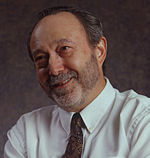Stephen Porges
This article contains wording that promotes the subject in a subjective manner without imparting real information. (December 2020) |
Stephen Porges | |
|---|---|
 | |
| Born | Stephen W. Porges 1945 (age 79–80) New Brunswick, New Jersey, United States |
| Nationality | American |
| Alma mater | Michigan State University, East Lansing, Michigan; US |
| Known for | Polyvagal theory |
| Scientific career | |
| Fields | Psychology |
| Institutions | Indiana University, University of North Carolina |
Stephen W. Porges (born 1945) is an American psychologist. He is the Professor of Psychiatry at the University of North Carolina at Chapel Hill.[1] Porges is currently the Director of the Kinsey Institute Traumatic Stress Research Consortium at Indiana University Bloomington,[2] which studies trauma.
He was previously a professor at the University of Illinois, Chicago, where he was director of the Brain-Body Center at the College of Medicine, and at the University of Maryland.
He proposed the still-unproven polyvagal theory in 1994, which is not endorsed by current social neuroscience.[3][4][5][6][7][8]
Porges is currently a psychologist with interests in cranial nerve responses, particularly as they relate to both humans and animals.
Personal life
[edit]He is married to scientist C. Sue Carter,[9] and has two children: Eric Carter Porges and Seth Porges.
References
[edit]- ^ University of North Carolina at Chapel Hill School of Medicine, accessed March 1, 2022
- ^ Indiana University Bloomington, accessed March 1, 2022
- ^ Todorov, Alexander; Fiske, Susan; Prentice, Deborah (2011). Social Neuroscience: Toward Understanding the Underpinnings of the Social Mind. Oxford University Press. ISBN 978-0-19-972406-2.[page needed]
- ^ Ward, Jamie (2016). The Student's Guide to Social Neuroscience. Psychology Press. ISBN 978-1-317-43918-9.[page needed]
- ^ Schutt, Russell K.; Seidman, Larry J.; Keshavan, Matcheri S. (2015). Social Neuroscience: Brain, Mind, and Society. Harvard University Press. ISBN 978-0-674-72897-4.[page needed] Litfin, Karen T.; Berntson, Gary G. (2006). Social Neuroscience: People Thinking about Thinking People. MIT Press. ISBN 978-0-262-03335-0.[page needed]
- ^ Baron-Cohen, Simon; Tager-Flusberg, Helen; Lombardo, Michael (2013). Understanding Other Minds: Perspectives from Developmental Social Neuroscience. OUP Oxford. ISBN 978-0-19-969297-2.[page needed]
- ^ Cacioppo, Stephanie; Cacioppo, John T. (2020). Introduction to Social Neuroscience. Princeton University Press. ISBN 978-0-691-16727-5.[page needed]
- ^ Decety, Jean; Cacioppo, John T. (2011). The Oxford Handbook of Social Neuroscience. Oxford University Press. ISBN 978-0-19-534216-1.[page needed]
- ^ "Unlocking the Love Code | Psychology Today".
